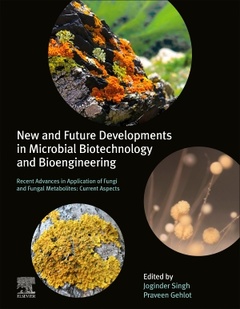Description
New and Future Developments in Microbial Biotechnology and Bioengineering
Recent Advances in Application of Fungi and Fungal Metabolites: Current Aspects
Coordinators: Panwar Joginder Singh, Gehlot Praveen
Language: English
Subject for New and Future Developments in Microbial Biotechnology...:
302 p. · 21.4x27.6 cm · Hardback
Description
/li>Contents
/li>Biography
/li>Comment
/li>
New and Future Developments in Microbial Biotechnology and Bioengineering presents an account of recent developments and applied aspects of fungi and its metabolites for human welfare. The fungi and its metabolites are employed in diverse fields of agri-food, biochemistry, chemical engineering, diagnostics, pharmaceuticals and medical device development. The book contains chapters by the eminent researchers working with fungi and fungal metabolites who explain their importance and potential in manifold prospects. The book includes a description of various fungal metabolites and their chemistry and biotechnology.
2. Recent advancement and biomedical applications of fungal metabolites
3. Thermophilic fungi: Diversity, Physiology, Genetics and Applications
4. Endophytic fungi: Novel source of bioactive fungal metabolites
5. Lichens: Fungal symbionts and their secondary metabolites
6. Lichen metabolites: An unadulterated cradle of bioactive compounds
7. Septin proteins and their role in regulation in fungi and yeast
8. Bioactive terpenoids from wild mushrooms
9. Arbuscular Mycorrhizal Fungi: Source of secondary metabolite production in medicinal plant
10. Bioactive secondary metabolites of endophytic fungi from medicinal plants
11. Bioactive natural products of endophytic fungi origin: production, activity and biotechnology
12. Genus Penicillium: Advances and application in the modern era
13. Aspergillus terreus: Taxonomy, biology and bioactive secondary metabolites with potential applications
14. Bioprospect potential of gasteroid mushrooms of the genus Astraeus
15. Chemical Creativity of Termitomyces mushrooms
Dr. Praveen Gehlot is Associate Professor, Department of Botany, Jai Narain Vyas University Jodhpur. He did his PhD from JNV University Jodhpur, under the able guidance of Prof. D.K. Purohit. He has about 18 years of teaching and research experience. He has been an awardee of Young Scientist under FAST Track Scheme by Department of Science and Technology, New Delhi and later worked as a Pool-Officer of Council of Scientific and Industrial Research, New Delhi. Earlier, he taught at Budha Institute of Technology and Science Research College, Jodhpur and Government Bangor PG College, Pali, Rajasthan and subsequently served as an Associate Professor and Head, Department of Microbiology, Maharaja Ganga Singh University, Bikaner, Rajasthan. Dr. Gehlot worked out three major research projects sponsored by UGC, DST and CSIR, New Delhi. He has published more than 80 research papers, book chapters
- Highlights the latest developments surrounding the utilization of fungi and fungal metabolites
- Overviews applied aspects of fungi and their metabolites for human welfare
- Details the usage of fungi and their metabolites in diverse fields
- Identifies the importance and potential of fungi and fungal metabolites in manifold prospects
- Illustrates recent trends in fungal metabolite research using elaborate, expressive tables and figures with concise information




